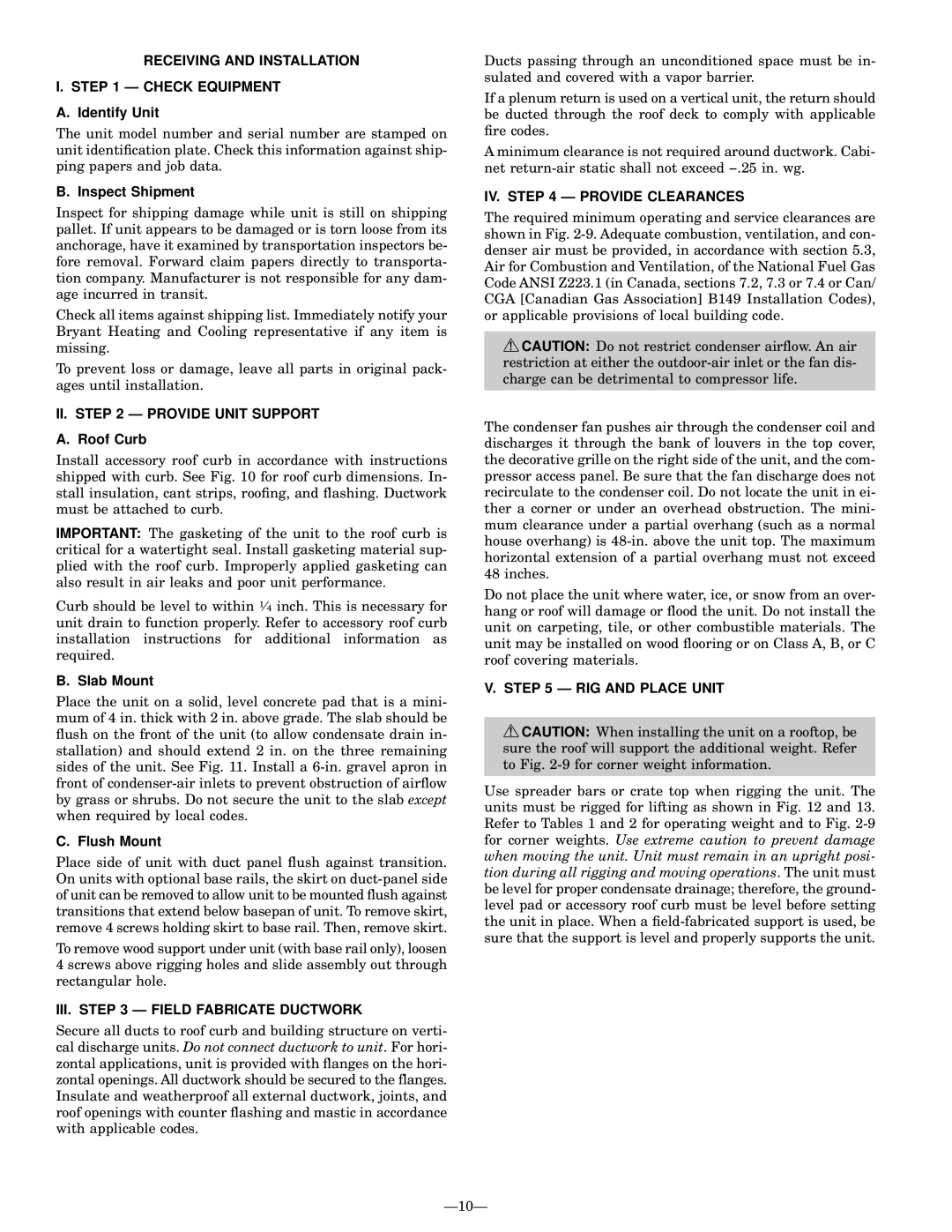RECEIVING AND INSTALLATION
I. STEP 1 Ð CHECK EQUIPMENT
A. Identify Unit
The unit model number and serial number are stamped on unit identi®cation plate. Check this information against ship- ping papers and job data.
B. Inspect Shipment
Inspect for shipping damage while unit is still on shipping pallet. If unit appears to be damaged or is torn loose from its anchorage, have it examined by transportation inspectors be- fore removal. Forward claim papers directly to transporta- tion company. Manufacturer is not responsible for any dam- age incurred in transit.
Check all items against shipping list. Immediately notify your Bryant Heating and Cooling representative if any item is missing.
To prevent loss or damage, leave all parts in original pack- ages until installation.
II. STEP 2 Ð PROVIDE UNIT SUPPORT
A. Roof Curb
Install accessory roof curb in accordance with instructions shipped with curb. See Fig. 10 for roof curb dimensions. In- stall insulation, cant strips, roo®ng, and ¯ashing. Ductwork must be attached to curb.
IMPORTANT: The gasketing of the unit to the roof curb is critical for a watertight seal. Install gasketing material sup- plied with the roof curb. Improperly applied gasketing can also result in air leaks and poor unit performance.
Curb should be level to within 1¤4 inch. This is necessary for unit drain to function properly. Refer to accessory roof curb installation instructions for additional information as required.
B. Slab Mount
Place the unit on a solid, level concrete pad that is a mini- mum of 4 in. thick with 2 in. above grade. The slab should be ¯ush on the front of the unit (to allow condensate drain in- stallation) and should extend 2 in. on the three remaining sides of the unit. See Fig. 11. Install a 6-in. gravel apron in front of condenser-air inlets to prevent obstruction of air¯ow by grass or shrubs. Do not secure the unit to the slab except when required by local codes.
C. Flush Mount
Place side of unit with duct panel ¯ush against transition. On units with optional base rails, the skirt on duct-panel side of unit can be removed to allow unit to be mounted ¯ush against transitions that extend below basepan of unit. To remove skirt, remove 4 screws holding skirt to base rail. Then, remove skirt.
To remove wood support under unit (with base rail only), loosen 4 screws above rigging holes and slide assembly out through rectangular hole.
III. STEP 3 Ð FIELD FABRICATE DUCTWORK
Secure all ducts to roof curb and building structure on verti- cal discharge units. Do not connect ductwork to unit. For hori- zontal applications, unit is provided with ¯anges on the hori- zontal openings. All ductwork should be secured to the flanges. Insulate and weatherproof all external ductwork, joints, and roof openings with counter ¯ashing and mastic in accordance with applicable codes.
Ducts passing through an unconditioned space must be in- sulated and covered with a vapor barrier.
If a plenum return is used on a vertical unit, the return should be ducted through the roof deck to comply with applicable ®re codes.
A minimum clearance is not required around ductwork. Cabi- net return-air static shall not exceed −.25 in. wg.
IV. STEP 4 Ð PROVIDE CLEARANCES
The required minimum operating and service clearances are shown in Fig. 2-9. Adequate combustion, ventilation, and con- denser air must be provided, in accordance with section 5.3, Air for Combustion and Ventilation, of the National Fuel Gas Code ANSI Z223.1 (in Canada, sections 7.2, 7.3 or 7.4 or Can/ CGA [Canadian Gas Association] B149 Installation Codes), or applicable provisions of local building code.
 CAUTION: Do not restrict condenser air¯ow. An air restriction at either the outdoor-air inlet or the fan dis- charge can be detrimental to compressor life.
CAUTION: Do not restrict condenser air¯ow. An air restriction at either the outdoor-air inlet or the fan dis- charge can be detrimental to compressor life.
The condenser fan pushes air through the condenser coil and discharges it through the bank of louvers in the top cover, the decorative grille on the right side of the unit, and the com- pressor access panel. Be sure that the fan discharge does not recirculate to the condenser coil. Do not locate the unit in ei- ther a corner or under an overhead obstruction. The mini- mum clearance under a partial overhang (such as a normal house overhang) is 48-in. above the unit top. The maximum horizontal extension of a partial overhang must not exceed 48 inches.
Do not place the unit where water, ice, or snow from an over- hang or roof will damage or ¯ood the unit. Do not install the unit on carpeting, tile, or other combustible materials. The unit may be installed on wood ¯ooring or on Class A, B, or C roof covering materials.
V. STEP 5 Ð RIG AND PLACE UNIT
 CAUTION: When installing the unit on a rooftop, be sure the roof will support the additional weight. Refer to Fig. 2-9 for corner weight information.
CAUTION: When installing the unit on a rooftop, be sure the roof will support the additional weight. Refer to Fig. 2-9 for corner weight information.
Use spreader bars or crate top when rigging the unit. The units must be rigged for lifting as shown in Fig. 12 and 13. Refer to Tables 1 and 2 for operating weight and to Fig. 2-9 for corner weights. Use extreme caution to prevent damage when moving the unit. Unit must remain in an upright posi- tion during all rigging and moving operations. The unit must be level for proper condensate drainage; therefore, the ground- level pad or accessory roof curb must be level before setting the unit in place. When a ®eld-fabricated support is used, be sure that the support is level and properly supports the unit.

